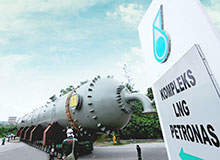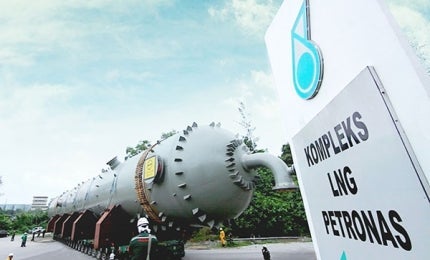

Petronas Bintulu LNG Complex, located approximately 20km from Bintulu Town, covers 276ha and currently accounts for 40.5% of Sarawak’s gross export, 6% of Malaysia’s total export and 4.2% of the country’s GDP. It includes three LNG plants with eight LNG trains in total. The three plants are respectively owned and operated by Malaysia LNG, MLNG Dua and MLNG Tiga, in joint venture with Petronas.
The complex is supplied with gas from gas fields in the Central Luconia area, which are located 125km to 275km offshore Bintulu, Sarawak. LNG from the complex is exported by vessels primarily to customers in Japan and China, and few more countries in the Asia Pacific. The shipping activities are overseen by MISC, a subsidiary of Petronas.
Subsidiary Petronas LNG Train 9 was created in January 2012 to add the ninth LNG train to the complex and revamp the existing Trains 4, 5 and 6. The 3.6 million tonnes per annum (mtpa) LNG Train 9 will increase the complex’s production capacity from 25.7mtpa to 29.3mtpa. It is scheduled for completion in late 2015.
Petronas Bintulu LNG complex details
The first train at the complex came online in August 1982 and the first cargo from the complex was exported to Japan in January 1983. Two more trains were commissioned in the first plant by 1984. Each train has a production capacity of 2mtpa.
The second plant, featuring LNG Trains 4 and 6 with a production capacity of 2.65mtpa each, came online in 1996, while the third plant featuring Trains 7 and 8, with a capacity of 3.8mtpa each, came online in 2004.
Petronas LNG Train 9 project details
The project will involve the construction and installation of gas receiving facilities, an acid gas removal unit, a dehydration and mercury removal unit, a fractionation and liquefaction unit, an LNG rundown unit, and associated utilities and facilities.
The new LNG train will also implement Air Product’s proprietary Split MRTM liquefaction process technology similar to the remaining trains.
The project will require an additional supply of approximately 850 million standard cubic feet per day (mmscfd) of feed gas from fields offshore Sarawak. It will benefit by using the existing storage and loading facilities within the complex.
EPCC contractor for Petronas LNG Train 9
The front end engineering design (FEED) studies and early works for the new LNG unit were completed in December 2012, under a dual FEED scheme, by JGC Corporation and the joint venture (JV) of Chiyoda Corporation and Saipem. JGC was awarded the $2bn engineering, procurement, construction and commissioning (EPCC) contract in March 2013 based on the results of the FEED studies.
Malaysian oil and gas company (Petronas) is developing a refinery and petrochemical integrated development project (RAPID) in Pengerang, Southern Johor.
JGC was awarded another EPPC contract worth JPY60bn (approximately $504m) in January 2015 to install piping and ancillary facilities to connect the existing six LNG storage tanks and the seventh new LNG storage tank with the shipping facilities at the complex. The company was also involved in constructing all the existing eight trains and is involved in revamping the existing Trains 4, 5 and 6.
Other contractors involved with the LNG Train 9
Gas turbo-compression equipment and variable speed drive systems for the liquefaction facility are being supplied by GE Oil & Gas, while air-cooled heat exchangers are being supplied by Hamon D’Hondt.
Ebara International was contracted in April 2013 to supply 12 cryogenic pumps and expanders for the project.
Contractual, commercial and quantity surveying services are being provided by Cannonway Energy. An absorber facility weighing 1,480t was transported from the Malaysian Bintulu port to the project site by Scheuerle.
The structural steel works and civil defence shelter doors for the project are being supplied by TTJ Holdings, while the steel structure erection works are being performed by Muhibbah Engineering.
Boil-off gas (BOG) re-liquefaction facility
The latest major activity at the complex prior to the implementation of the Petronas LNG Train 9 Project involved the installation of the 1,840t/d capacity new boil-off gas (BOG) re-liquefaction facility to reliquefy the excessive BOG evaporating out of the LNG storage tanks.
The facility incorporates Linde’s proprietary LNG process and core cryogenic heat exchanger. Siemens supplied a cryogenic-temperature BOG turbo compressor and a single-casing LNG-refrigerant turbo compressor. The compressors are both driven by Siemens’ SGT-700 mechanical drive gas turbines.


